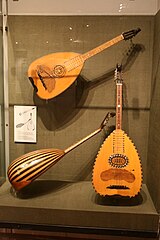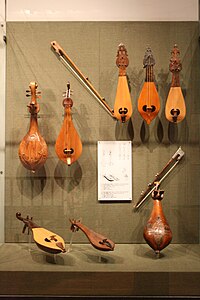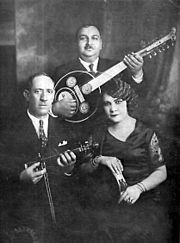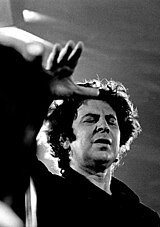Music of Greece
This article needs additional citations for verification. (July 2018) |
 | ||||||||
| Music of Greece | ||||||||
| General topics | ||||||||
|---|---|---|---|---|---|---|---|---|
| Genres | ||||||||
|
||||||||
| Specific forms | ||||||||
| Media and performance | ||||||||
|
||||||||
| Nationalistic and patriotic songs | ||||||||
|
||||||||
| Regional music | ||||||||
|
||||||||
| Part of a series on the |
| Culture of Greece |
|---|
 |
| People |
| Languages |
|
Mythology |
| Cuisine |
| Festivals |
|
Art |
The music of Greece is as diverse and celebrated as its
.Greek musical history
Greek musical history extends far back into
Ancient Greece
In
.Music was an important part of education in ancient Greece, and boys were taught music starting at age six. Greek musical literacy created a flowering of development; Greek
Roman era
Due to Rome's reverence for Greek culture, the Romans borrowed the Greek method[2] of 'enchiriadic notation' (marks which indicated the general shape of the tune but not the exact notes or rhythms) to record their music, if they used any notation at all.
Byzantine era
The tradition of eastern liturgical chant, encompassing the

Ottoman era
The
By the beginning of the 20th century,
Folk music (dimotiká or demotic)


Greek folk music is found all throughout Greece,
Nisiótika
Nisiotika is a general term denoting folk songs from the Greek islands, especially the Aegean Islands. Among the most popular types of them is Ikariótiko tragoúdi, "song from Ikaria".
Ikariótikos
Modern nisiótika
Singer Mariza Koch was largely responsible for the revival of interest in Nisiótika in the 1970s and 1980s.[6] During the 1990s and 2000s, singers such as Yiannis Parios and Stella Konitopoulou helped this music gain occasional mainstream popularity.
Cretan music

The
Cretan music in media
The Cretan music theme
Other folk traditions
This section needs expansion. You can help by adding to it. (December 2008) |
Other major regional musical traditions of Greece include:
- Music of the Heptanese
- Music of Epirus
- Music of Macedonia
- Music of Thrace
Notable artists
|
Composers: |
Singers:
|
Classical music
Ionian School

It was through the
The Church music (Byzantine) of the islands is also different from the rest of Greece, with significant western and Catholic influences on the Orthodox rite.
Greek National School
Popular music
Greek operetta and early popular songs


The
The most successful songs during the period 1870–1930 were the so-called Athenian serenades (Αθηναϊκές καντάδες), and the songs performed on stage (επιθεωρησιακά τραγούδια 'theatrical revue songs') in
- Kritikopoula (Spyridon Samaras, 1916)
- The Godson (Theophrastos Sakellaridis, 1918)
- I want to see the Pope (Theophrastos Sakellaridis, 1920)
- Oi Apachides ton Athinon (Nikos Hatziapostolou, 1921)
- Beba (Theophrastos Sakellaridis, 1928)
After 1930, wavering among American and European musical influences as well as the Greek musical tradition, Greek composers begin to write music using the tunes of the
Notable artists
(1910s–1960s)
|
Composers:
|
Singers:
|
Rebetiko

Rebetiko was initially associated with the lower and poor classes, but later reached greater general acceptance as the rough edges of its overt subcultural character were softened and polished. Rebetiko probably originated in the music of the larger Greek cities, most of them coastal, in today's Greece and Asia Minor. Emerged by the 1920s as the urban folk music of Greek society's outcasts. The earliest Greek rebetiko singers (refugees, drug-users, criminals and itinerants) were scorned by mainstream society. They sang heartrending tales of drug abuse, prison and violence, usually accompanied by the bouzouki.
In 1923, after the
With the coming of the
Some of the earliest legends of Greek music, such as the quartet of Anestis Delias, Markos Vamvakaris, Stratos Payioumtzis and Yiorgos Batis came out of this music scene. Vamvakaris became perhaps the first renowned rebetiko musician after the beginning of his solo career. Other popular rebetiko songwriters and singers of this period (1940s) include: Dimitris Gogos (better known as Bayandéras), Stelios Perpiniadis, Spyros Peristeris, Giannis Papaioannou, and Apostolos Hatzichristos.
The scene was soon popularized further by stars like
Éntekhno

Drawing on
Theodorakis was the first composer to use the bouzouki in this genre of music, trying to include this organ into the mainstream culture. Other significant Greek songwriters included
A specific form of éntekhno was the so-called "political song"; songs with political message, of the Left, which arose during the
Notable éntekhno works include:
- Six folk paintings (Manos Hatzidakis, 1951)
- Epitaphios (Mikis Theodorakis, 1960, poetry by Yiannis Ritsos)
- Epifania (Mikis Theodorakis, 1962, poetry by Giorgos Seferis)
- Dead brother's song (Mikis Theodorakis, 1962)
- Mikres Kyklades (Mikis Theodorakis, 1963, poetry by Odysseas Elytis)
- To Axion Esti (Mikis Theodorakis, 1964, poetry by Odysseas Elytis)
- Gioconda's Smile (Manos Hatzidakis, 1965)
- Romiossini (Mikis Theodorakis, 1966, poetry by Yiannis Ritsos)
- Ballos (Dionysis Savvopoulos, 1970)
- O Megalos Erotikos (Manos Hatzidakis, 1972)
- Eighteen Short Songs of the Bitter Motherland (Mikis Theodorakis, 1973, poetry by Yiannis Ritsos)
- Our Great Circus (Stavros Xarchakos for the theatrical play of Iakovos Kambanellis, 1974)
- Tetralogia (Dimos Moutsis, 1975, poetry by Constantine P. Cavafy, Kostas Karyotakis, Yiannis Ritsos and Giorgos Seferis)
- Stavros tou Notou (Southern Cross) (Thanos Mikroutsikos, 1979, poetry by Nikos Kavvadias)
Notable artists
|
Composers: |
Singers:
|
Laïkó

Other significant songwriters and lyricists of this category are considered
During the same era, there was also another kind of soft music (ελαφρά μουσική, also called ελαφρό, elafró 'soft (song)', literally 'light') which became fashionable; it was represented by ensembles of singers/musicians such as the Katsamba Brothers duo, the Trio Kitara, the Trio Belcanto, the Trio Atene and others. The genre's sound was an imitation of the then contemporary Cuban and Mexican folk music,[13] but also had elements from the early Athenian popular songs.
Notable artists
Modern laïká
Modern laïká emerged as a style in the early 1980s. An indispensable part of the contemporary laïká culture is the písta (πίστα; pl.: πίστες) "dance floor/venue". Night clubs at which the DJs play only contemporary laïká where colloquially known on the 1990s as ellinádika. Over the years until today, the aim of Greek music scene is only one: quality. Virtuoso musicians and expressive singers take every season, with more professionalism and love for what they do to entertain the Greek audience, to lure and to make it dance with the songs and music that everyone loves. All this music effort take place in
Renowned songwriters of modern laïká include
- 2010s
In the 2010s, several new artists emerged. Artists, such as Kostas Martakis, Panos Kalidis, Ioakim Fokas, Stella Kali, Stan, Katerina Stikoudi, Demy and X-Factor contestants such as Konstantinos Argyros, Eleftheria Eleftheriou and Ivi Adamou. Several artists sometimes incorporated dance-pop elements in their laïko-pop recordings.
Terminology
In effect, there is no single name for modern laïká in the Greek language, but it is often formally referred to as σύγχρονο λαϊκό ([ˈsiŋxrono laiˈko]), a term which is however also used for denoting newly composed songs in the tradition of "proper" laïkó; when ambiguity arises, σύγχρονο ('contemporary') λαϊκό or disparagingly λαϊκο-ποπ ('folk-pop', also in the sense of "westernized") is used for the former, while γνήσιο ('genuine') or even καθαρόαιμο ('pureblood') λαϊκό is used for the latter. The choice of contrasting the notions of "westernized" and "genuine" may often be based on ideological and aesthetic grounds.[14]
Criticism
Despite its popularity, the genre of modern laïká (especially laïko-pop) has come under scrutiny for "featuring musical clichés, average singing voices and slogan-like lyrics" and for "being a hybrid, neither laïkó, nor pop".[15]
Skyládiko
Skyládiko (Greek pronunciation: [sciˈlaðiko]; pl.: Skyládika; Greek: Σκυλάδικο, meaning "doghouse") is a derogatory term to describe some branches of laïkó music and some of the current nightclubs in Greece in which a form of popular Greek music is performed. It is performed with electric bouzouki and guitars. It is associated with mass entertainment of lower quality and until the 1970s was marginal, but gained popularity after the 1980s. Critics of this genre relate it with modern laïká, mentioning the low quality and the indispensable common part of the pista (πίστα, pl.: πίστες) "dance floor/venue".[16]
Other popular trends

New Wave (Néo Kýma)
Folk singer-songwriters (τραγουδοποιοί) first appeared in the 1960s after
Political song
A notable musical trend in the 1970s (during the
Other
Nikos Xydakis, one of Savvopoulos' pupils, was among the people who revolutionized laïkó by using orientalized instrumentation. His most successful album was 1987's Kondá sti Dóxa miá Stigmí, recorded with Eleftheria Arvanitaki.
Thanasis Polykandriotis, laïkó composer and classically trained bouzouki player, became renowned for his mixture of rebetiko and orchestral music (as in his 1996 composition "Concert for Bouzouki and Orchestra No. 1").
A popular trend since the late 1980s has been the fusion of éntekhno (urban folk ballads with artistic lyrics) with pop / soft rock music (έντεχνο ποπ-ροκ).[19] Moreover, certain composers, such as Dimitris Papadimitriou have been inspired by elements of the classic éntekhno tradition and written songs cycles for singers of contemporary éntekhno music, such as Fotini Darra. The most renowned contemporary éntekhno (σύγχρονο έντεχνο) lyricist is Lina Nikolakopoulou.

There are however other composers of instrumental and incidental music (including filmscores and music for the stage), whose work cannot be easily classified, such as Stamatis Spanoudakis, Giannis Spanos, Giorgos Hatzinasios, Giorgos Tsangaris, Nikos Kypourgos, Nikos Mamangakis, Eleni Karaindrou, and Evanthia Remboutsika. Vangelis and Yanni were also Greek instrumental composers who became internationally renowned.
Even though it has always had a considerable number of listeners supporting it throughout the history of the post 1960s Greek music, it is only very recently (late 2000s) that pop-oriented music has reached the popularity of laïkó/laïká, and there is a tendency among many urban folk artists to turn to more pop-oriented sounds.[20]
Artists
The following classification is conventional and categories may occasionally overlap with each other. Each artist is entried under the genre designation that the Greek musical press usually classifies him or her.
Laïkó / Néo Kýma
1960s–1970s
Laïkó / Skiladiko
1970s–2010s (songs from this period of Greek laïkó were mainly influenced by the music skydaliko, including branch of laiko music and some of the current nightclubs in Greece in which this music is performed, the country music movement and style folk-pop)
- Chryspa
- Lefteris Pantazis
- Giorgos Mazonakis
- Giorgos Xanthiotis
- Katerina Stanisi
- Nancy Alexiadi
- Nikos Makropoulos
- Panagiotis Psaltis
- Eleana Papaioannou
- Sofia Petrou
- Nikos Vertis
- Haris Kostopoulos
- Peggy Zina
- Dionysis Makris
- Yannis Ploutarchos
- Kelly Kelekidou
- Maro Litra
- Lillian Madianou
- Sotis Volanis
- Nikos Kourkoulis
- Vasilis Karras
- Panos Kiamos
- Ioanna Koutalidou
- Konstantinos Thalassohoris
- Christina Koletsa
- Pericles Stergianoudes
- Artemis Alexandratou
- Loukas Alexandrou
- Paola Foka
- Antzy Samiou
- Anneta Marmarinou
- Antonis Kardamillis
- Zafeiris Melas
- Stamatis Gonidis
- Hristina Anagnostopoulou
- Christos Kyriazis
- Angela Dimitriou
- Antypas (singer)
- Themis Adamantidis
- Christos Menidiatis
- Roula Stavrou
laïkó
1980–2010s
|
|
Europop
1990s–2010s
- Artemis Gounaki (record producer, musical arranger)
- Hi-5 (girl group)
- Kalomira
- Sarbel
- Alcazar (group)
- Despina Olympiou
- Aspa Tsina
- Pandora (singer)
- Roxette (Swedish-Greek Pop band)
- A*Teens(Swedish-Greek Pop band)
- Antique (band)
- Velvet (singer)
- 4 Play (Greek Pop band)
- Cue (band)
- Da Buzz (Swedish-Greek Pop band)
- Bosson (Swedish-Greek Pop singer)
- Ace of Base (Swedish-Greek Pop band)
- Måns Zelmerlöw
- Mystique (Greek Pop band)
- Friends (Swedish band)
- Haris Varthakouris
- Michalis Hatzigiannis (Cypriot-Greek singer)
- One (Cypriot-Greek boy band)
- Giannis Vardis
- Fame (duo)
- Tamta
Rock / soft rock
1970s-1980s
- Poll
- Nostradamos
- Socrates Drank the Conium
- Spyridoula
- Adiexodo (Greek Alternative/Punk band)
- Genia Tou Chaous
- Deus ex Machina
- Panx Romana (Greek Rock band)
1990s–2010s
- Ble (Greek Rock band)
- C:Real (Greek Pop Rock band)
- Trypes
- Xylina Spathia
- TNT (Norwegian band)
- Giorgos Dimitriadis
- The Hellacopters (Swedish-Greek Rock band)
- Kent (band)
- Backyard Babies
- Diafana Krina
- Mavri Magioneza
- Morá Sti Fotiá
- Domenica
- Kore. Ydro. (Indie rock band)
- Locomondo (reggae and ska band)
2000s–2010s
- Bitch Alert (Finnish-Greek Rock band)
- Crucifield Barbara (Finnish-Greek Rock band)
- Infidelity (Indie rock band)
- Monika Christodoulou
- Emigre (Greek Alternative band)
- The Hives (Swedish Rock band)
- HIM (Finnish Band)
- DumDum Boys (Norwegian-Greek Rock band)
- Kitrina Podilata
- Gymna Kalodia (Greek Rock band)
- Motivo 4 (Greek Rock band)
- Endelekheia (Alternative Band)
- Lambretta (band)
- Matisse (Post-Punk revival, Indie rock)
- Pop punk)
- ONAR
- Onirama
- Sahara Hotnights (Swedish-Greek Rock band)
- Stalingrad Cowgirls (Finnish-Greek Rock band)
- Joanna Drigo
- The Rasmus (Finnish-Greek Rock band)
- Raining Pleasure (anglophone Indie rock band)
- Minor Project
- Rosebleed (Alternative band)
- Simon Bloom
- Sunrise Avenue (Finnish-Greek Rock band)
- The Skelters (anglophone rock band)
- Theodosia Tsatsou (Alternative)
- Ypogeia Revmata (rock band)
Alternative
1980s-1990s
- The Last Drive
- Popsicle (band)
- The Earthbound
- Broder Daniel (Swedish-Greek Alternative band)
- Poor Rich Ones (Norwegian-Greek Indie band)
- The Cardigans (Swedish-Greek Alternative band)
- Psyched Up Janis (Danish-Greek Indie band)
- Madrugada (band)
- Mew (band)
- Ephemera (band)
- Antonis Livieratos
- Speaker Bite Me (Greek Indie band)
- Stereo Nova
- Midnight Choir (Norwegian-Greek Alternative band)
2000s–2010s
|
Mainstream hip hop / R&B
1990s–2010s crews
- Imiskoúmbria
- Stereo Mike (solo artist)
- ZN
- Active Member
- Sadahzinia
- Stavento
- Timbuktu (musician)
- Midenistis (Greek Hip-Hop singer)
- Stixoima
- Madcon (Norwegian-Greek Hip-Hop band)
- Ominus (Greek Hip-Hop singer)
- Goin' Through (Greek Hip-Hop band)
- Nevma (Greek Hip-Hop band)
- Lazee (Swedish-Greek Hip-Hop band)
- Looptroop Rockers (Swedish-Greek Hip-Hop band)
- Professional Sinnerz (Greek Hip-Hop band)
- Warlocks (band)
- Rodes(Greek Hip-Hop band)
- Feven (Swedish-Greek Hip-Hop singer)
- Sifu VERSUS
- Kafe Piperies
- Taki Tsan
- Terror X Crew
- TUS (Greek Hip-Hop singer)
- FF.C
Independent music scenes

Since the late 1970s various independent scenes of "marginal" musical genres have appeared in Greece (mainly in Athens, Piraeus, and Thessaloniki). Most of them were short-lived and never gained mainstream popularity but the most prominent artists/bands of these scenes are critically acclaimed today and are considered among the pioneers of independent Greek music (each one in their own genre).
Genres
- Greek jazz ('70s: Sphinx (band), Sakis Papadimitriou, Floros Floridis, Manolis Mikelis)
- Greek blues ('80s–'10s): Blues Wire
- prog rock / art rock ('70s–'80s: Socrates Drank the Conium, Aphrodite's Child, Pavlos Sidiropoulos, Spyridoula (band), Nikolas Asimos, Vasilis Papakonstantinou, Dimitris Poulikakos)
- synthpop / gothic rock ('80s bands: Metro Decay, Film Noir, Villa 21, Anti Troppau Council; 2000s: Marsheaux)
- Genia Tou Chaous, Deus ex Machina, Panx Romana)
- , Dytikes Synoikies)
- Indie rock (Anglophone 1990s and 2010s bands: The Last Drive, The Earthbound, I Knew Them, Film, Closer, Abbie Gale, Infidelity, Waterpipes, Monika Christodoulou)
- Low Bap (Active Member, Sadahzinia, Babylona - Βαβυλώνα) / Greek hip hop (FF.C, Terror X Crew, DJ ALX, Sifu VERSUS, Eisvoleas - Εισβολέας, ZN MCs - Ζήτα Νι MCs, Vita Peis - Βήτα Πεις, Razastarr, Voreia Asteria - Βόρεια Αστέρια, Alytoi Grifoi - Άλυτοι Γρίφοι, Rodes - Ρόδες)
- Uplifting trance ('90s: Cyan, Cherouvim, Darma, Star Children)
- )
- Septic Flesh, Ravencult, Astarte, Zemial, Naer Mataron, Varathron, Necromantia, Mortuus Caelum, Thou Art Lord) / folk black metal (Kawir, Fiendish Nymphe — sister project of the renowned Ancient Greek music revival band Daemonia Nymphe)
- Harry Klynn, Aéra Patéra (band))
- Neo-classical ('90s–'10s: Chaostar)
- Underground / cult / outsider music ('90s–'10s: Lost Bodies)
See also
- Music of Cyprus
- Anatolian Greek music (including Pontic Greek music)
- Greek music in Israel
- Guardians of Hellenism
- Heptanese School, the first major school (style) of Greek classical music
- List of Greek composers
- List of Greek folk musicians
- List of Greek musical artists
- Notable bouzouki players
- List of Greek guitarists
- List of Greek composers for the classical guitar
- Music of the Greek immigrant community in the United States
Notes
- ^ Samuel Baud-Bovy, Δοκίμιο για το Ελληνικό Δημοτικό Τραγούδι, 3rd edition, Πελοποννησιακό Λαογραφικό Ίδρυμα, Ναύπλιο: 1966, pp. 1–13. (Υπάρχει μια συνεχής εξέλιξη από την αρχαία Ελληνική μουσική έως και το δημοτικό τραγούδι, η οποία μαρτυρείται, εκτός από τη γλώσσα, στο ρυθμό, τη δομή και τη μελωδία).
- ^ Ulrich 1963, p. 25
- ^ Kartomi 1990, p. 124
- ^ Greek Orthodox Archdiocese of America.
- ^ The Columbia Electronic Encyclopedia, 6th ed. 2007 - "Byzantine music"
- ^ "Home - Program in Hellenic Studies" (PDF). Retrieved 23 December 2015.
- ^ Xepapadakou, Avra (2013). "Pavlos Carrer [Paolo Karrer]". Grove Music Dictionary. New York: Oxford University Press.
- ^ Ioannis Foulias, “The composer Dimitri Mitropoulos and his relation to the Greek National School of Music”, Contribution to the Conference "The National Element in Music", Athens Concert Hall, 18–20 January 2013. Organization: Faculty of Music Studies of the University of Athens, Music Library of Greece "Lilian Voudouri".
- ^ Administrator. "music-art - ΓΙΑ ΤΗΝ ΕΛΛΗΝΙΚΗ ΜΟΥΣΙΚΗ". Retrieved 23 December 2015.
- ^ "Κυρίαρχη αισθητική και μουσικό γούστο" - article on 'Kathimerini' Archived 2011-07-16 at the Wayback Machine
- ^ "When Progress Fails, Try Greekness: From Manolis Kalomiris to Manos Hadjidakis and Mikis Theodorakis": Paris Konstantinidis, When Progress Fails, Try Greekness: From Manolis Kalomiris to Manos Hadjidakis and Mikis Theodorakis, in Nikos Maliaras (ed.), "The National Element in Music" (Conference proceedings, Athens, 18–20 January 2013), University of Athens, Athens 2014. pp. 314–320.
- ^ greekdance.dancenews.gr - "Ο ορος λαικοι χοροι " Archived 2009-08-30 at the Wayback Machine
- ^ "Music, Greece, Greek music and songs". Retrieved 23 December 2015.
- ^ "Οι εφτά ψυχές του λαϊκού τραγουδιού - ΑΡΧΕΙΟ ΠΟΛΙΤΙΣΜΟΥ - Η ΚΑΘΗΜΕΡΙΝΗ". Archived from the original on 1 November 2012. Retrieved 23 December 2015.
- ^ Τάσος Π. Καραντής. "Ποιο είναι το λαϊκό τραγούδι σήμερα; - e-orfeas.gr. Με άποψη στη μουσική και στο τραγούδι". Retrieved 23 December 2015.
- ^ "Το έτυμον της λέξεως "σκυλάδικο" - Απόψεις - Η ΚΑΘΗΜΕΡΙΝΗ". Retrieved 23 December 2015.
- ISBN 960-7555-39-2 (online version).
- ^ "Πολιτικό Τραγούδι - Ελληνική Μουσική Πύλη". Retrieved 23 December 2015.
- ^ In contemporary use though, the terms έντεχνο ποπ, and έντεχνο ροκ may be ambiguously used to denote, respectively, Grecophone indie pop and alternative rock, not necessarily having the typical characteristics of éntekhno.
- ^ Τα Νέα Οnline (23 September 2009). "Εξορίζουν το λαϊκό για να μας κάνουν ποπ". Τα Νέα Οnline. Retrieved 23 December 2015.
References
- Kartomi, Margaret J. (1990), On Concepts and Classifications of Musical Instruments, ISBN 0-226-42548-7.
- Ulrich, Homer, and Paul Pisk (1963). A History of Music and Musical Style. New York: Harcourt Brace Jovanoich. LCCN63013512.
- Broughton, Simon and Ellingham, Mark with McConnachie, James and Duane, Orla (Ed.), World Music, Vol. 1: Africa, Europe and the Middle East, pp. 126–142. Rough Guides Ltd, Penguin Books. ISBN 1-85828-636-0.
- Notaras, Giorgos. Το ελληνικό τραγούδι των τελευταίων 30 χρόνων, 1991. ISBN 960-236-148-4.
- Kalogeropoulos, Takis. Λεξικό της Ελληνικής μουσικής, editions Γιαλλελή, 2001. ISBN 960-7555-39-2.
- Dubin, Marc and Pissalides, George (liner notes). Songs of the Near East, 2001.
- Ordoulidis, Nikos. ‘The Greek popular modes.’ British Postgraduate Musicology, 11 December 2011
- Xepapadakou, Avra (2013). Pavlos Carrer, Athens: FagottoBooks ISBN 9789606685521
- Xepapadakou, Avra (2013). "Pavlos Carrer [Paolo Karrer]". Grove Music Dictionary. New York: Oxford University Press.
External links
- BBC Radio 3 Audio (60 minutes): Epirus - Polyphony and Petroloukas Chalkias. Accessed November 25, 2010.
- BBC Radio 3 Audio (60 minutes): Southern Greece and Crete. Accessed November 25, 2010.
- Audio clips: Traditional music of Greece. Musée d'ethnographie de Genève. Accessed November 25, 2010. (in French)
- Greek Music Portal by IEMA an introduction to Greek Music in English and Greek
- Greek Music Encyclopedia (in Greek)
- Helleniccomserve: Short History of Greek Music
- ANA.com: The Music of Greece
- Kithara.to: A collection of some 11,000 Greek songs, with lyrics and chords (in Greek) (formerly kithara.vu)
- Greek music database (in Greek)
- Old Greek songs database (in Greek)
- Music Heaven: Greek music e-zine (in Greek)
- Klika: A site about Greek Rebetiko, Laïkó, and traditional music (in Greek)
- Tabsy.gr: Greek music tablatures database (in Greek)
- Rembetiko Forum: A forum about Greek Rebetiko, Laïkó and Traditional music (in Greek)
- Greek Songs and Greek Music: Articles about Greek Music and Greek songs with their story and lyrics translated to English
- Traditional Greek folk music downloads
- Tabachaniotika (Magrini)
- Mediterranean musicians in America (Signell)
- Greek Clarinet Music
- Folk dances of the Greek regions
- Ensemble Kérylos, a music group led by scholar Annie Bélis and dedicated to the recreation of ancient Greek and Roman music

